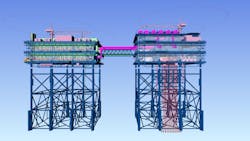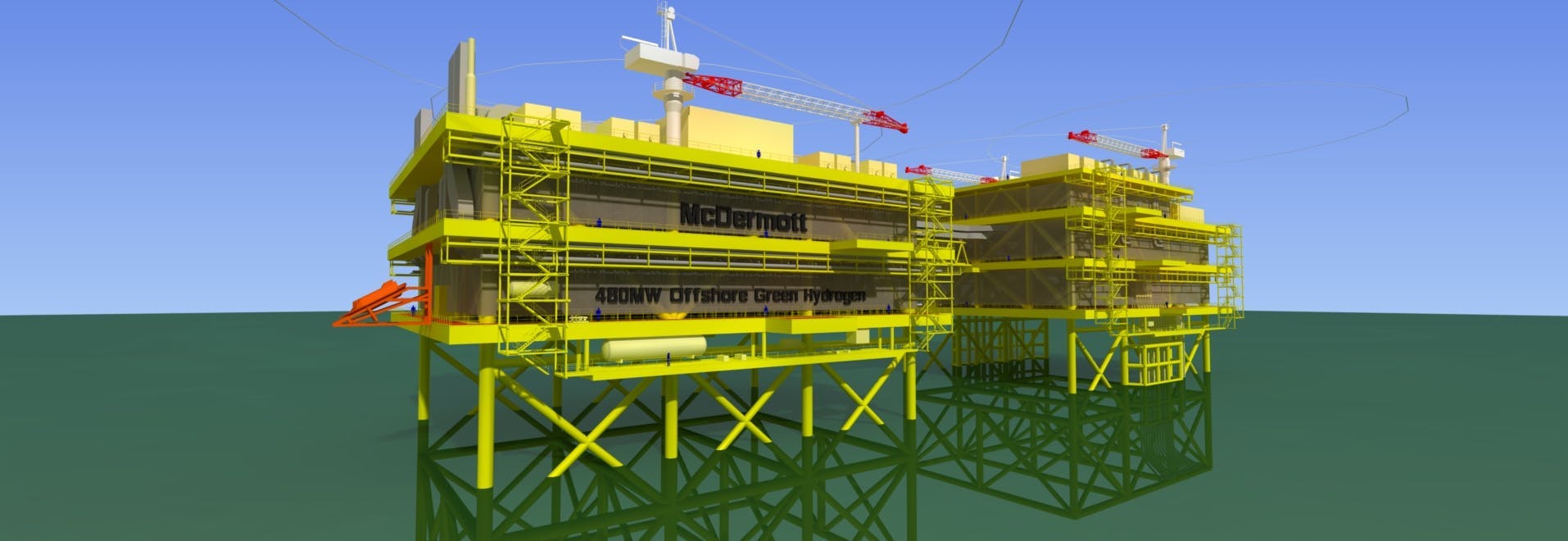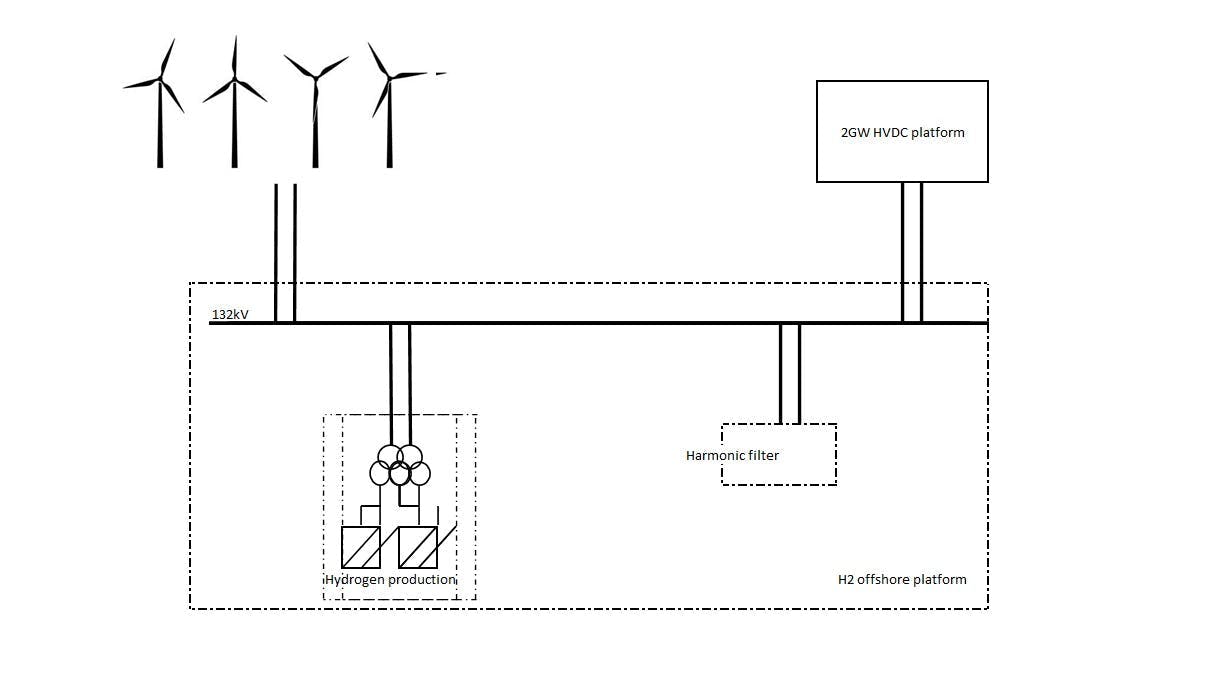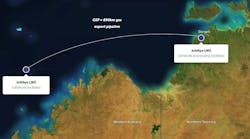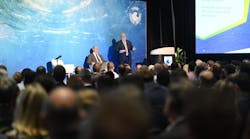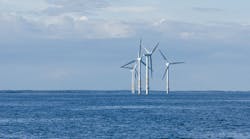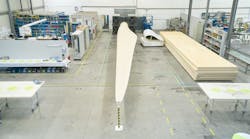Editor's note: This feature article first appeared in the January-February 2024 issue of Offshore magazine. Click here to view the full issue.
By Ron Vis and Vincent van Duijvenbode, McDermott
Rising demand for hydrogen as a new clean source of power will drive the emergence of gigawatt-scale green hydrogen production installations close to offshore wind farms.
Various pilot projects are under development and early-phase small-scale hydrogen production facilities are being installed in the Dutch North Sea. There are no large-scale green hydrogen installations operating offshore anywhere at present although again, several schemes are under development or planned. These include the recently announced 100-MW Demo1 and 500-MW Demo2 green hydrogen project in Europe that will be powered by wind and which is due to start operating after 2031.
To address the challenge of scaling up production while at the same time minimizing environmental impact, McDermott is investigating the potential for green hydrogen production on a large offshore installation, drawing on the company’s experience in offshore high-voltage direct-current (HVDC) transmission and onshore electrolysers. There is market interest in electrolyser facilities in the range 300 to 500 MW for this purpose with the offshore solutions in a centralized or decentralized arrangement.
The team went through several iterations and brainstorming sessions before determining the optimal design basis. Issues considered included the type of electrolyser, proton exchange member (PEM) or alkaline; installation of electrolyser modules versus the split of stack and arrays and electrical equipment; integration of a single platform vs the split in a hydrogen production facility; and use of a power transformer and utility platform.
The concept settled on was a fully independent hydrogen facility that could be connected to a set of Wind Turbine Generators (WTGs) providing power input of 132 kV, seen as potentially the next standard voltage level offshore. The facility contains all electrical power transforming and harmonic filtering equipment to receive and transform the power to a DC voltage level feeding the electrolysers. Associated modules include sea water lift, filtration and desalination, treatment, and purification; nitrogen and air systems; drain and vent, hydrogen dryer and de-oxygen systems; and finally, compression to suit the export pipeline pressure.
The current centralized design features split platforms, with the process platform presenting a higher level of risk due to the large inventories of hydrogen (H2). The utility platform houses general supporting services, power transformation and living quarters: separation by distance is seen as the safest method of ensuring personnel safety, hence the bridge link between the two topsides.
In general, the safety principles are driven by separation to minimize the potential for hazardous releases, keeping the electrical installations away from locations with high volumes of hydrogen and oxygen, and forced ventilation to prevent explosive atmospheres. The electrical design is based on multiple 132-kV feeders from a nearby wind farm with the size of the wind turbine clusters determining the number of incoming feeders. In future, the maximum electrical capacity of a single offshore wind turbine will likely be 20 MW.
The selected distribution voltage of 132 kV for the wind farm enables installation of a single double busbar HV GIS. Due to the current limitation of 3,150A (4,000A in exceptional cases), a distribution voltage of 66kV would lead to duplication of the double busbar HV gas-insulated switchgear (GIS) and a complicated downstream distribution. The likelihood is that in the near future, grid operators will accept 132 kV as offshore distribution voltage.
Based on this, a 20-MW wind turbine capacity and a submarine cable of 1 x 3 x 800 sq mm (considered the maximum size for handling the purpose intended), seven wind turbines can be connected to a cluster. For a required power generation capacity of around 630 MW, 32 x 20-MW wind turbines would be the minimum, resulting in at least five clusters of seven wind turbines.
To suit offshore operations flexibility, the 132-kV GIS can also be connected to a nearby 2-GW HVDC platform with the same number of cables from the wind farm, with the generated power used either for production of hydrogen, exported to the HVDC platform, or for a hybrid operation case.
The purpose of the Information Communication Technology (ICT) system in this study is to provide a concept that fully supports unmanned/remote control of the offshore platform. The design assumes that a remote location is available onshore and that a connection is provided through a redundant fiber optic network. The platform will be equipped with a control room providing localized control, as back-up to the remote operation.
Future studies will involve a further investigation into autonomous operation. The ICT design basis is prepared to meet a level between 2 and 3 of the autonomous level scale. To achieve a higher level of autonomy, both the scope and client expectations must be addressed as early as possible in the development phase.
The production platform topside has 24 arrays on each deck level with the top deck accommodating the compression system and all ventilation and air handling systems. The utility topside supports all electrical and utility systems and includes rooms for system controls and safeguarding, space reserved for living quarters, and technical rooms for maintenance activities. At present the facility includes lifeboat escape, a helideck and pedestal cranes for maintenance and heavy lifting.
McDermott has designed identical jackets for both facilities with respect to legs, cross bracings, and pile configuration. Details such as J-tubes and supports for SW intake conducts are specific to the utility platform jacket, in addition to the export pipeline J-tube for the hydrogen production platform.
The weight report and cost estimating work are complete and data can be made available to interested parties. Furthermore, the building blocks developed for this approximately 500-MW facility can be scaled up or down, depending on the project’s needs.
Global targets for increased use of renewable energy will not be met solely via the production and transport of power from wind farms via HVDC facilities to shore. The concept of transferring electrons into hydrogen via an offshore hydrogen production facility is a technically feasible alternative. McDermott’s offshore knowledge and hydrogen production, combined with its fabrication capability, can support this development.
About the authors:
Vincent van Duijvenbode is a Principal Piping Engineer at McDermott. He has more than 25 years of experience in piping layout/plant design of offshore and onshore facilities throughout various project stages from concept, FEED to full EPC detailed design.
Ron Vis is Project Director at McDermott based at the office in The Hague. He has led the McDermott Floating LNG program from its conception and provides leadership and support to the modularization execution model. He has over 35 years of experience with projects in the oil and gas and petrochemical industries.
